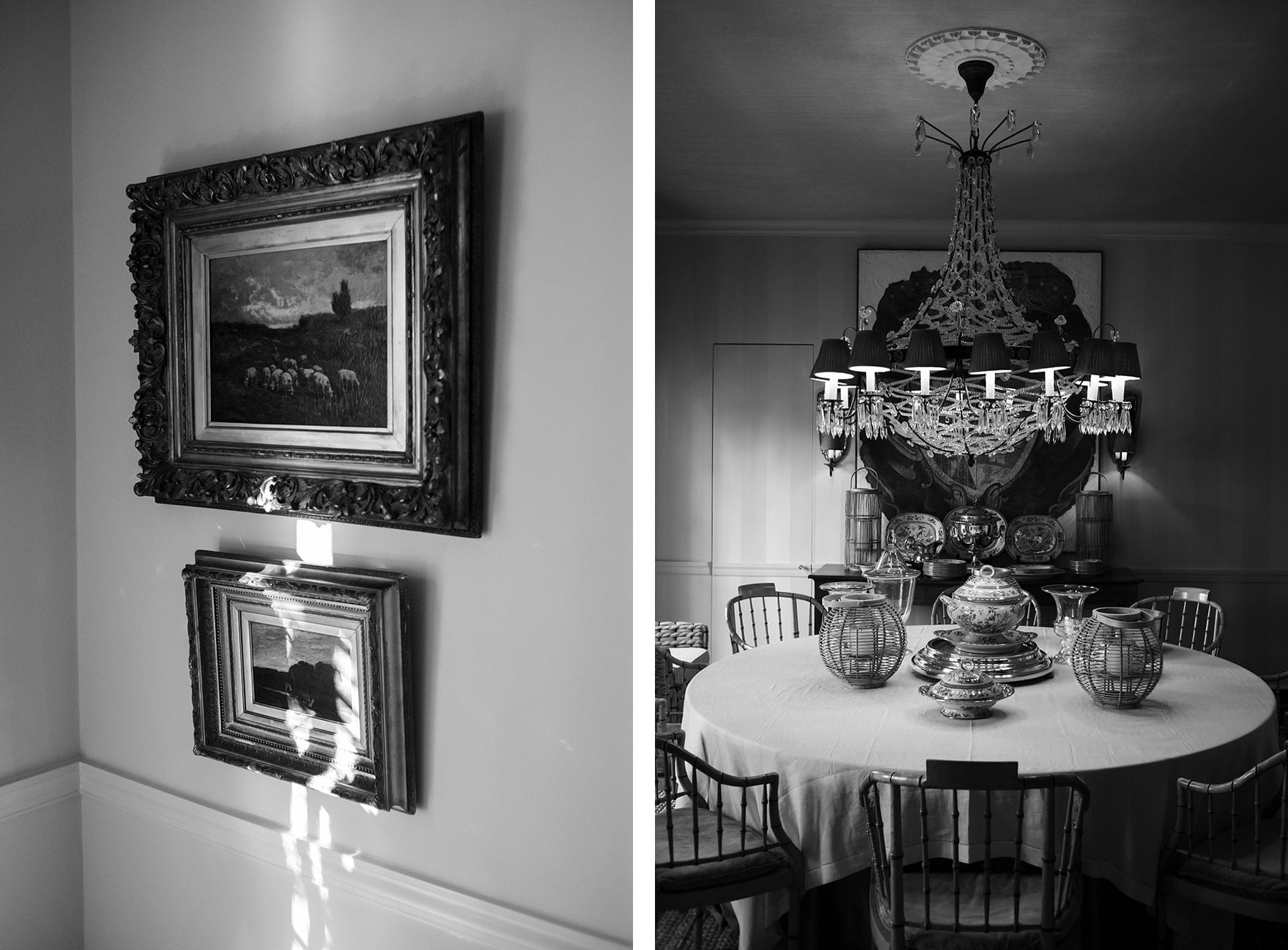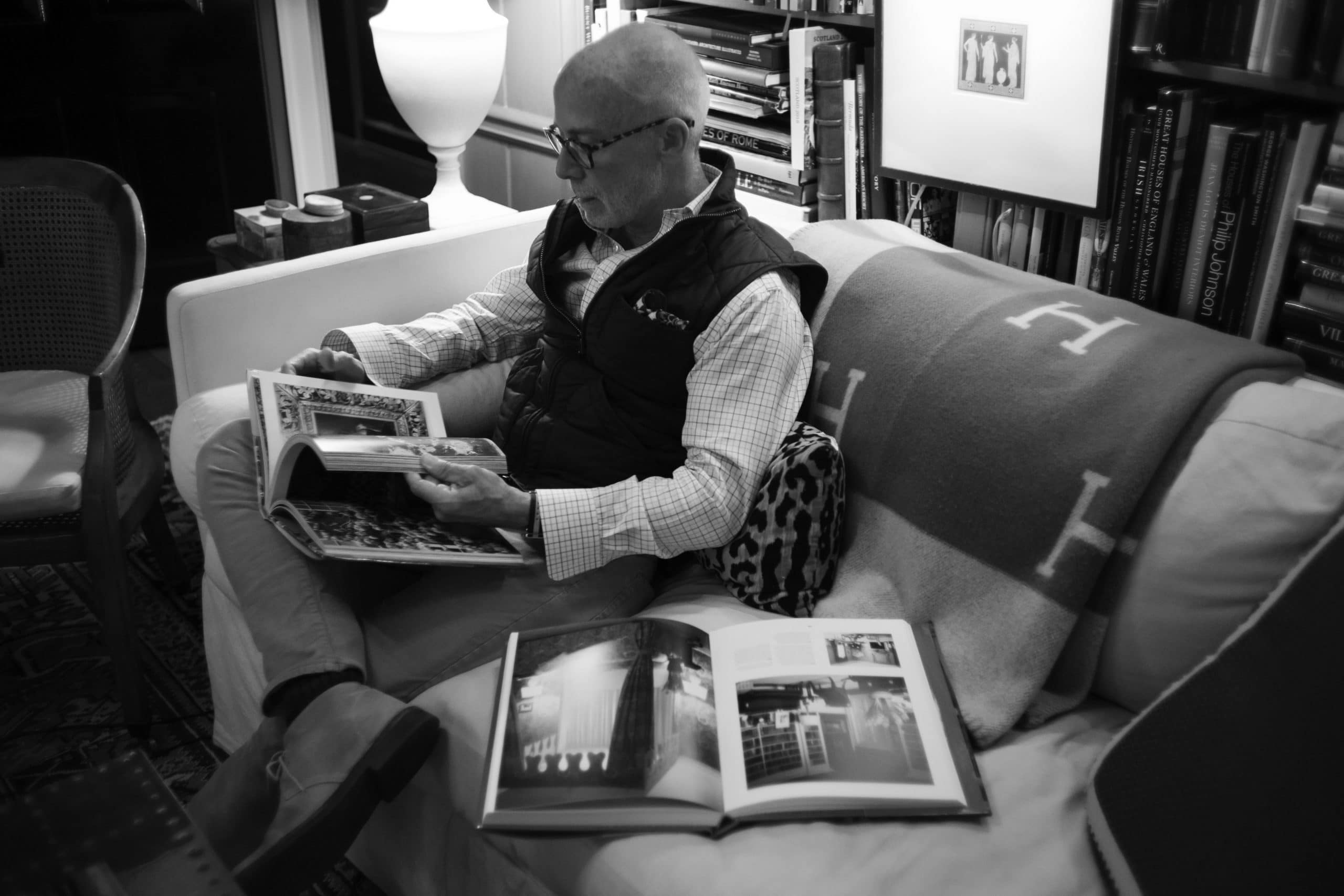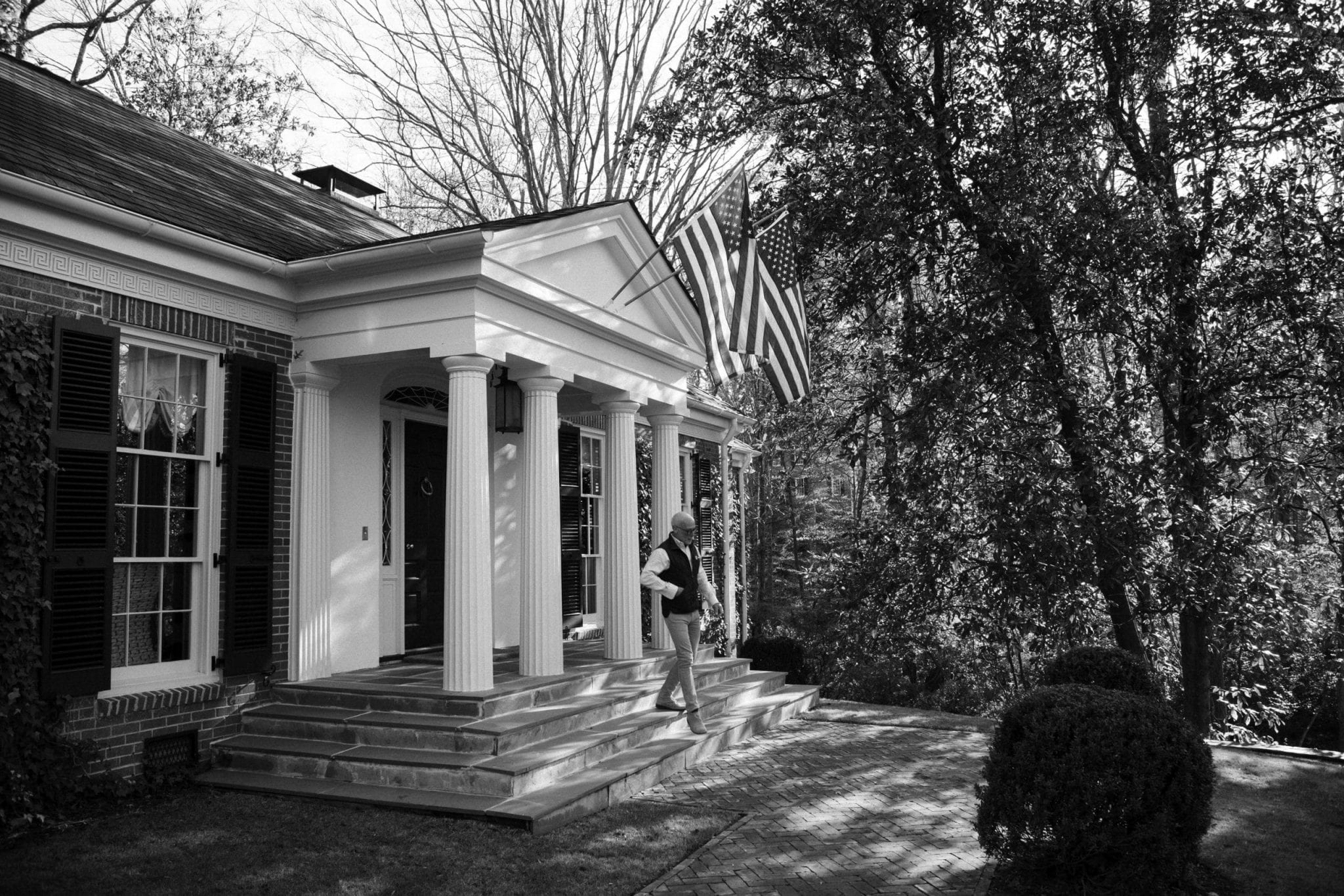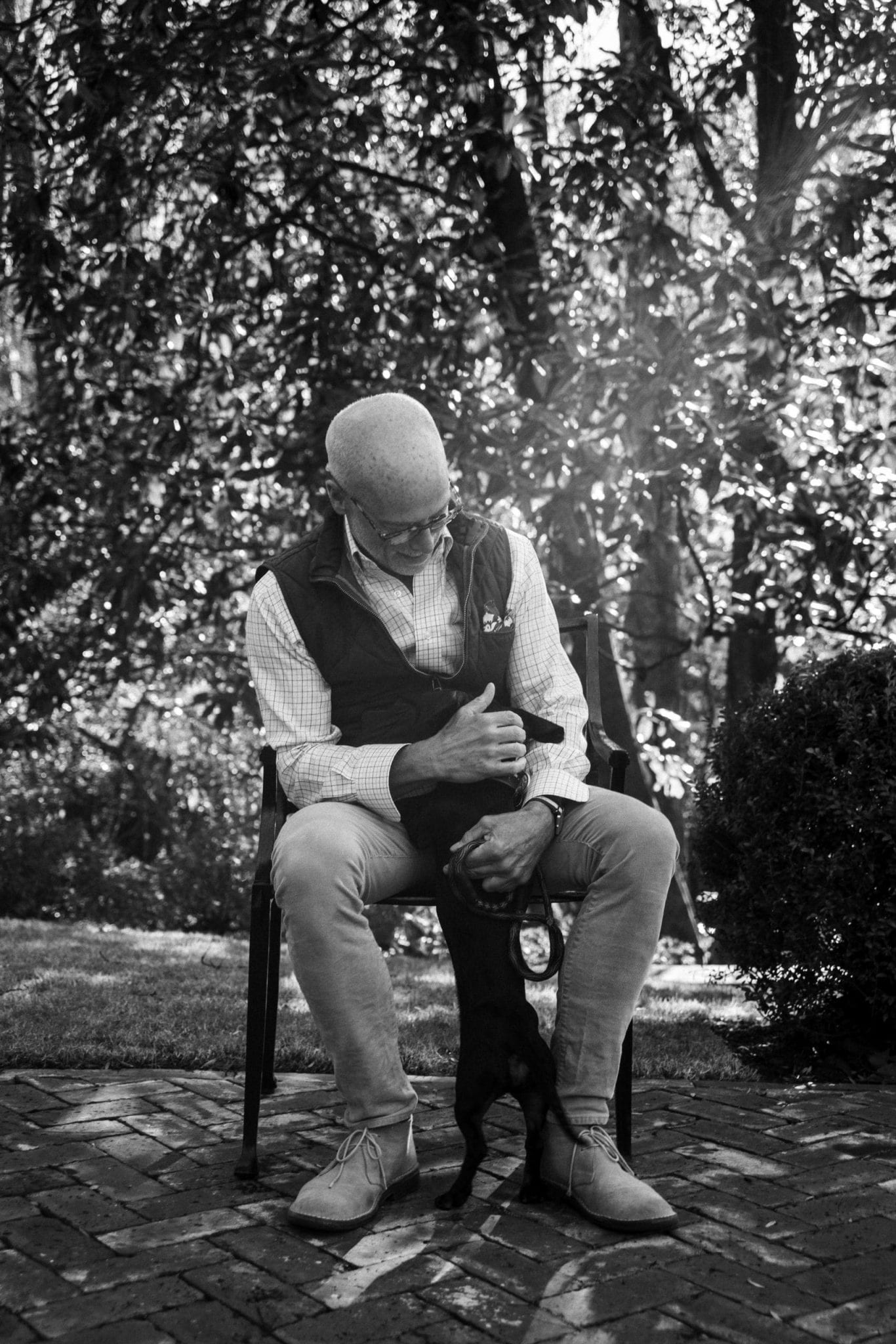A list of things about Bill Ingram. He is not interested in building one kind of home. Instead he follows his obsessions with detail and history and design and landscape and melds them with what he has learned of his client, then designs and builds something particular and meaningful, rooted in time and space, different each time. Also, a home must have space for all the different parts of a life. There must be space for function and space for rest and space for peace of mind. He will remind a client that life will not always look the way it does now— the children will indeed grow, tricycles will become cars will become college friends will become grandchildren. His favorite drink is one he knows every bar and restaurant can make. His favorite place to travel is a place he returns to every year. He draws at his office because if he allowed a space for drawing in his home, he would never stop. For Bill Ingram, in other words, everything has its time and place.
During my time with Bill, I could not help but think of a line from a William Carlos Williams poem: “No ideas but in things.” When my questions allowed for philosophical or abstract answers, Bill responded with the tangible, the concrete. When he talked about design, he talked about the plan. When asked about his history, he responded with anecdotes. Questions about his processes and design ideals were met with stories about specific clients, specific landscapes, specific homes. The result was a profoundly visual effect, one that Williams would have liked— I’ve had to remind myself in the days since that I have not actually seen photos of, let alone been inside, the spaces he described for me. If I had though, and even without having done so, I can imagine I would find them so real and so right that they may not feel so new.
Bill Ingram: I don’t like to talk about myself so you may just have to pull it out of me.
Cassie Condrey: I’ll do my best. Let’s start here. How has the South influenced your work? Its landscape and diversity, its idiosyncrasies and vernacular, even your history here? Bill: It comes naturally to me because it’s all I know. Being raised here, I saw all the old houses, the kinds of houses you see when you ride down the road, just funny old houses you don’t know anything about that are just in your mind. Unfortunately, a lot of them are vanishing, those kinds of houses that are part of the culture and part of the landscape here. They bring up, I hate to say the word earthiness, but there is something about them that came from the place— whether it’s the type of wood that’s used or the bricks made locally. They were made of materials that came from close by because it was hard to get here and hard to transport things. That brought a whole different style and method of building. They were simple houses, designed to accommodate the weather.
An example of how those things stuck with me—I had a lake house that I built for myself that felt like an old house even as a brand new house. It just had certain things that you don’t really see in new houses anymore. It had windows that lined up front to back, like in an old house where you needed cross-ventilation; there weren’t awkward two story spaces, it didn’t have that, it just had high ceilings; the windows went up really high and you could raise them up; it had big french doors and a screen porch that was at the end of a row of rooms and you walked through one room to get to another and things like that. I don’t think I made an outwardly conscious effort to be Southern; it’s just what came out of my thought process of what that house ought to be and that’s the way it ended up. It really did feel like it had always been there. I had all the windows and doors made in a mill shop that was about thirty minutes down the road. It had cypress beams and cypress ceilings and it had old style reproduction hardware on the doors that were a combination of brass and iron. All of that together just worked in that way.
Cassie: You didn’t sit down to build a house that felt old? You just built a house that made sense to you based on what you’d seen and experienced? Bill: Right, I didn’t set out to make any kind of reproduction house. It just needed to feel like it belonged there and it had been there awhile. I did make the conscious effort to not make it look new and shiny when it was built. I reluctantly sold it recently but it’s about thirteen years old and it never changed from when I built it. It looked the same. It got a little softer, a little better over time, but it wasn’t the kind of house where you had to worry about anything. If you got a circle on a table or you put your feet up on something, it really was just fine. It had old floorboards and there was just enough about it that was soft and easy. As nice as it was, everybody felt comfortable immediately when they walked in.
Cassie: It sounds like a perfect Southern house. You’re talking about people feeling comfortable and feet up on things. I think hospitality and a sense of ease and simplicity is part of the character of the South. Bill: Absolutely. I had a lot of clients come to that house before I designed theirs and I don’t think that they would walk in and say this is what I want, but it would be enough that they would feel comfortable for me to design theirs and be sure they would get that quality in theirs. Without knowing exactly how I’d achieve it, they would just trust that I would.
Cassie: It’s interesting you're talking about the random houses. I grew up really rural and we were always on the road because we were an hour from everything. So, I got to know these little houses on all these backroads that I just loved. Even as a child, I just wanted to walk into them. They did all have an earthiness, like they just grew up out of the ground. It called you to imagine the stories of all the people who had lived there. It had a real influence on my creativity and I can imagine it could be the same for you, an architect who thinks about homes and spaces and structure. Bill: Definitely. Like you said, some would become really familiar to you because of roads you went down all the time. You’d always look at them and see what was going on with them. You’d eventually over time see that they weren’t lived in or they were falling down. It’s like they never got better. They just always stayed the same or got worse. Then you feel sort of tied to them after awhile, after seeing them over and over.
Cassie: It's sad to see them go. What does simplicity mean to you? I enjoyed reading on your website your thoughts on modesty and simplicity. Bill: Simplicity starts for me with the plan. These days there are so many complicated functions and rooms that are not that attractive that you have to have in a house. I don’t like for those to be that dominant even though they can account for a third of the house. Laundry and mud rooms and closets—everybody is closet crazy—and exercise rooms. People want and need to have them, but they’re not comfortable rooms, just utilitarian, an outgrowth of utility. But they can amount to a lot of space and so you have to figure out where to put them so that you don’t end up with this cobweb mess of all these rooms that are interfering with the rooms you live in and relax in and entertain in and can be yourself in. I try to combine those or make them more discreet.
It’s just not making the house feel complicated so that when you’re walking down the hall you’re not passing all this crazy stuff to get to the room that you’re trying to go to. At the same time, it’s also not about an open plan. People think that they can just take out walls, but that is not always simple. All of your mess is then in one big visual experience. If you have a place to put stuff, that’s going to simplify your life. If you’ve got somewhere to put things so that where you are is clutter free and organized, then you can have peace. I think that one third of the house has to be the functional stuff. That’s why that’s important. That helps you have a little more peace to your life because you can tuck things away.
Cassie: So it’s about balance, too. You have these rooms that can be pretty simple and soothing to the eye and the soul and spirit and these other rooms that are functional. Bill: I get clients all the time who want some kind of backdoor entrance before you get into the house which is usually the kitchen. They say their kids are going to drop everything right there on the kitchen counter. If you don’t give them a little speed bump when they walk in and a place to drop everything first, it’s going to be right up under you, right where you’re trying to cook and feed and live the rest of the evening. It’s very stressful when all that stuff is right underneath you.


Cassie: Your work shows that you enjoy history, that you study history and have respect for it. Would you call yourself a history buff? Bill: I would. I think everything I do is rooted in history. I don’t like to do the same house over and over so everything is from some different part of history. I love the Colonial era, for instance, but that isn’t something I do over and over. If a client’s house requires a more modern aesthetic, there are modern things that are historic or have historic precedent, too, and that’s just as intriguing to me.
Cassie: Can you tell us more about your love of the details of the past and how that influences your work? Bill: Woodworking is fascinating to me and how wood is joined and why moldings are put together like they are. A lot of moldings, for instance, were based on some precedent from days before that were carved out of stone from the Greeks and Romans.
In this country, a lot of houses and people who built in the early days were doing so out of wood. Then they had to join that wood— that’s put together so much more differently than stone would be— and then there’s different ways the grain of the wood is treated. You don’t really have end grains of wood exposed, usually you wrap that with another piece of wood and then you have to do things to shed water. All of that is how wood is put together. Doors and windows are built up to push water back out so that it drains back out and doesn’t rot the wood. There’s a whole system to that— not just done to look pretty but mostly to keep water away and keep wood protected. That kind of thing is so fascinating to me.
Cassie: It really is. Even if you aren’t in the field, if it isn’t useful or relevant to you, it’s still fascinating. You’re bringing all of that to your work— you care about the details. You’re also wanting it to feel authentic and not easily put together. Bill: I thought builders and carpenters would understand what I do with those details. But you have to tell them. A lot of times they do it the cheaper or less involved way because now there are so many ways to cut corners. You go in new houses that have things just kind of irrationally slapped together and I’m not saying these guys are trying to cheat, that’s just the way a lot of things are done now. And we have to tell them, no, we want this trimmed like it would have been done in whatever time period we’re going for. And once you expose them to that concept, that is what you’re going for, it’s almost like a lightbulb goes off and they’re like okay, I get what you mean.
Cassie: When blending traditional and modern, what makes a “happy marriage” between the two? How do they make each other better? How do you approach it or think about it? Bill: That’s a good question, we have to do that all the time. Well, I think even with a more open or more casual floor plan, a floor plan more for today you might say, I still think a house requires a certain amount of formality, or implied formality. It doesn’t have to live formal and I certainly don’t want anything stiff, but a little bit of formality gives you some order. The lake house I was talking about, it had a little bit of formality. There was an implied formality to the symmetry at the front of the house and it really helped people understand what was to come next.
Once inside, you realized the living room was in the center and there were equal rooms on either side and the same kind of relationship happened upstairs. There was a central room and bedrooms on either side. It was the most relaxing place. I think most people would want to go to the lake. It helped generate the connection to the old, yet it lived perfectly easy and you could take your shoes off the second you got there if that’s what you wanted to do. The first thing I took off when I got there was my watch. I was at ease. I shook off the whole world when I got there.
Cassie: When designing a home, how do you relay a sense of place and story? Where do you begin? It sounds like you explore the history of where it will be but I imagine you also get to know your clients in some way, their own histories. Bill: I do. It’s funny, I know them so much more by the time we finish. I think you get away with a little bit more when you’re just learning about them and don’t know everything, because if you knew them really well, you would probably hold back on what you thought they might go for. If you don’t know them as well, you take a little bit of a risk and maybe you push them a little more. And that probably works out better for both of you. First thing I do when I lay out a house is I look at the property. The property starts to tell me a lot about the house. They may give me a basic idea of their number of rooms and the kinds of things that they want. But as far as how it’s arranged and how it is going to end up looking, I think the property tells you a lot about that. That connects you to the land right there. I’ve had clients that bring me one of their sketches or a photo of some house they love and I never give them any guarantee that what they’re going to end up with is going to look like that. It may have the feel of it, or if there’s a peacefulness about it or if there is some character about it, that I can kind of dig around and find out that’s really what they’re after, then I’ll make sure they have that.
Cassie: You must have a unique, somewhat intimate connection with your clients. Your knowing what they value, where they want to put things, if they’re messy or clean, if they like to sleep in or not. I’m sure you ask all kinds of questions. What does that process look like? How do you create a home specifically for them? Bill: Well, I spend some time with them initially just talking to them. I ask them some questions. Most of them, if you start talking to them a little bit, they’ll start telling you all sorts of things that they may not even think you’re registering but I just listen to what they say about how their day goes or how they interact with each other or if one gets up and one sleeps or if they travel. What they’re up to. One may say, “oh I’ve got to have my bedroom dark,” and the other may say, “I don’t care about that but I want my own separate closet because he’s messy or whatever.”
You hear about all those kinds of things. They do love it when you remember and that it's registered with you. That process is more about me listening to them and not me talking.
Cassie: It’s more paying attention than prying. Bill: I had one recently, I don’t think that they told me a whole lot other than how they were going to use the house. It was a place they were going to retire to so they had some technicalities that we knew the house would need. Other than that I don’t think they told me a whole lot except she said she liked to walk into a house and have a hallway that was lateral, that went left to right. I thought that was the strangest thing to tell me although I didn’t have any aversion to that, I kind of thought that was cool. We didn’t dwell on that topic, I think she just mentioned it and that was kind of it. So when I designed the house and they saw the floor plans for the first time weeks later, she said, “oh I see you’ve got my lateral hallway that goes left to right.” It just thrilled her to death. She was all set up to like the rest of it because that one little thing I had not forgotten to do.
Cassie: Building a home is such a personal process. I imagine that to have someone who just notices and pays attention is really a relief for people. They get to kind of let out what they’re thinking without feeling pressure or expectation or like they need to answer correctly. They just get to be themselves, that’s really nice. Bill: Yeah that’s right. A lot of people come to me and they almost act a little nervous at times, “oh you’re going to have to bear with us, we’ve never built before,” and I say “ don’t worry, almost no one has or you wouldn’t be here. So this should be the fun part for you. I’ll take care of worrying about the rest. Just tell me what you want and enjoy the process.”
Cassie: What a gift you’re giving. Good for you. We’ve touched on this, but to make sure I have it covered… What gives a home longevity? What makes it a home, gives it a sense of permanence? Bill: A few things and these may all sound like quick answers but: real materials because nothing ages better than real materials; avoiding too many trends, in fact avoiding as many as you can.
Cassie: All, hopefully. Bill: Yeah, all. It goes back to the plan, and you will have some people who really get worked up about a lot of idiosyncrasies about their life and what they want in their plan. And that’s fine, but don’t get it so kooky that it’s just gonna fail later on. You’ve gotta adapt a little. If it’s simpler, it’s going to work for you in a million different ways. If your kids are say 4, 6 and 8, well by the time you get in the house, they’re going to be 6, 8 and 10 and they are going to be teenagers ready for college before you know it and then they’re going to be gone and you’re going to be in this house without them and they're going to be coming home and they’re going to be bringing friends. The whole thing is going to change from tricycles and bicycles to them with their cars and them with their friends. So it is better that we also think about what life looks like down the line, and not only with little kids. I realize they’re little, but they’re not little forever, and then all of a sudden you’ve got grandkids. Some of them almost start crying if I start talking too much like that but you have to think about it.
Cassie: So, bigger isn’t always better? Bill: Don’t get me wrong, I love big houses. I’ll do big. But I’m not a snob about the size of a house. Smaller can also be right.
Cassie: What does it mean to design an Alys Beach home? Bill: To be in a place where design is the foremost thought—everything there is design oriented— is fun. That’s really great and it registers with people. When people hear that you’re doing something there or if somebody knows I’m going there, they’re instantly jealous. I want to go, I’ve got to get down there, is what they’re thinking. I certainly love being down there and designing there and seeing what’s going on. It seems to have no end.
Cassie: Of course it’s a place that values design and also with it a simplicity and a grace and a beauty. They are focused on creating something beautiful there. That must be really cool for someone like you when those are the benchmark words. Bill: It truly is.
Cassie: We’re moving a little more personal. Bill: I’m just drinking water, should I find something else?
Cassie: We’ll see…I believe creativity begets creativity. In other words, the practice of other art forms allows our primary creative work to flourish. It stretches us. What other creative outlets enliven you? Do you have any other hobbies or passions or obsessions? Bill: I think I’m obsessed about everything that I do. Just in general, my ideas with my architecture also carry through to the interiors and the landscape and the whole picture of everything. So I don’t want to just say I like the decorating but I like the full finish of the interiors of a project. For the house in Alys we did all the landscape design for them. I collaborated with the owner and then we tweaked it by what kind of plants we could find and what she wanted to see differently. I like to do that for clients, I like to do that for myself. I’ve got some old cars, three old Jaguars. I don’t work on them but I like piddling with them and driving them. I love rotating those to drive around. I like traveling places. I wouldn’t say I shut down but I like to go places and get away from my work and explore.
Cassie: What else inspires you? What in your day to day life gives you energy? Bill: Day to day life? I like my workouts. It clears my head, gets my head ready for the day and I can think about things, as well as it just makes me feel better. If somebody had ever told me that I’d get up at 4:15 in the morning to walk and workout, I’d think they were crazy, but I just wouldn’t feel right if I didn’t. That alarms goes off and I’m just up. I don’t lie there and think ugghhh, I just get up. I would feel like I was missing something without it.
Cassie: What’s your perfect weekend? What cocktail are you drinking? What are you eating? Where are you? Bill: Mostly I think a perfect weekend is one at home and not doing a whole lot except my little routine around my house or around town. I’m not a big foodie but I don’t like to go hungry. I don’t like to cook but I will because I don’t like to go hungry. I get hungry a lot. Just relaxing at home. I do like to have a bourbon and water when I have a drink, Makers Mark and water. I don’t know why I’m on that except that it’s easy. Most places just have it. Once you like something you hate to go somewhere where they don’t have it. Then you’re not going to enjoy something else as much. It’ll be fine but it’s just not what you drink, you’re not going to be as happy.
Cassie: Do you listen to music when you design? Bill: Usually I don’t. Usually I just let my head be kind of clear.
Cassie: Do you draw by hand? Bill: Pencil and paper. It’s the only way I know how to do it. Everything I do is that way.
Cassie: What about reading? All those books behind you? Bill: Mostly architecture books, art and design. I read some. Usually by the time I relax enough to read though, I fall asleep.


Cassie: We haven’t talked about this. Was there something in your childhood— did you know early you wanted to be an architect? Bill: I knew fairly early because I knew I liked to draw. And I didn’t know any other kids who liked to draw. And I didn’t know any architects. I think that was the only thing that kept me from saying that early on is that I just didn’t know any. When I was an early teenager, I started drawing houses and house plans. I had a little loose-leaf binder of my little plans. Sometimes would draw them for friends at school, they would ask me to draw them one. I’d kind of forgotten that and about five or six years ago I got a letter to my office from a friend from high school that had looked me up and she said she had found a house that I drew for her way back then and she made a copy of it and sent it to me in the letter. She said she found it and she hoped one day she could still build it. I was kind of horrified, I thought oh my God there’s no telling what I drew. And I looked at it and it wasn’t too bad. I was kind of like okay well I’ve seen worse get built than this, this is really a pretty good house. I thought it was really sweet that she’d thought enough of it that she’d saved it all these years.
Cassie: Really sweet. Bill: Yeah. Floor plans and a drawing of a front. Actually I think it was all four sides too.
Cassie: Wow, even elevations at that age. Bill: Four elevations and two plans. I would have charged her a lot of money for that now. (laughs)
Cassie: Maybe she’ll build that house. Lucky her. I really enjoyed this, a pleasure. Thank you so much.















